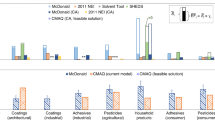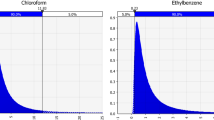Abstract
This study involved an assessment of chloroform formation due to the use of hypochlorite-containing detergents in dishwashers. The objective of this research was to quantify in-home formation of trihalomethanes, particularly as related to dishwasher usage. A series of 14 flask and 15 laboratory experiments were completed. Flask experiments involved the mixing of food with dishwasher detergent in water for a 12-min reaction period, and were intended to identify chemicals and relative levels of those chemicals that may form from dishwasher usage with different food groups. Liquid concentrations of chloroform ranged from 1 to 41 mg/l. Laboratory experiments involved collection of liquid and gas samples over the course of an operating cycle with an actual residential dishwasher. Background concentrations of chloroform in the water supply were generally between 0 and 10 μg/l; liquid chloroform levels in the wash cycle were typically at least 50 μg/l. Chloroform concentrations were as high as 20 μg/l in the dishwasher headspace. Using mass balance equations for a typical residential house and laboratory results from this research, predicted concentrations resulting from dishwasher usage were similar to typical background concentrations in residential dwellings.
This is a preview of subscription content, access via your institution
Access options
Subscribe to this journal
Receive 6 print issues and online access
$259.00 per year
only $43.17 per issue
Buy this article
- Purchase on Springer Link
- Instant access to full article PDF
Prices may be subject to local taxes which are calculated during checkout






Similar content being viewed by others
References
Andelman J.B . Inhalation exposure in the home to volatile organic contaminants of drinking water. Sci Total Environ 1985: 47: 443–460.
Ashworth R.A., Howe G.B., Mullins M.E. and Rogers T.N . Air–water partitioning coefficients of organics in dilute aqueous solutions. J Hazard Mater 1988: 18: 25–36.
Giardino N.J. and Wireman J.R . Total body burden from inhalation during showering with benzene-contaminated drinking water: implications for cancer risk. J Hazard Mater 1998: 62(1): 35–40.
Giardino N.J. and Andelman J.B . Characterization of the emissions of trichloroethylene, chloroform, and 1,2-dibromo-3-chloropropane in a full-size, experimental shower. J Expos Anal Environ Epidemiol 1996: 6(4): 413–423.
Gossett J.M . Measurement of Henry's law constants for C1 and C2 chlorinated hydrocarbons. Environ Sci Technol 1987: 21(2): 202–208.
Howard C. and Corsi R.L . Volatilization of chemicals from drinking water to indoor air: role of the kitchen sink. J Air Waste Manag Assoc 1996: 46(9): 830–837.
Howard C. and Corsi R.L . Volatilization of chemicals from drinking water to indoor air: the role of residential washing machines. J Air Waste Manag Assoc 1998: 48(10): 907–914.
Howard-Reed C., Corsi R.L. and Moya J . Mass transfer of volatile organic compounds from drinking water to indoor air: the role of residential dishwashers. Environ Sci Technol 1999: 33(13): 2266–2272.
Jo W.K., Weisel C.P. and Lioy P.J . Routes of chloroform exposure and body burden from showering with chlorinated tap water. Risk Anal 1990: 10(4): 575–580.
Keating G.A., McKone T.E. and Gillett J.W . Measured and estimated air concentrations of chloroform in showers: effects of water temperature and aerosols. Atmos Environ 1997: 31(2): 123–130.
Li-Chen E., Nakai S. and Wood D.F . Relationship between functional (fat, binding, emulsifying) and physicochemical properties of muscle proteins. Effects of heating, freezing, pH and species. J Food Sci 1985: 50: 1034.
Little J.C . Applying the two-resistance model theory to contaminant volatilization in showers. Environ Sci Technol 1992: 26(7): 1341–1349.
McKone T.E . Human exposure to volatile organic compounds in household tap water: the indoor inhalation pathway. Environ Sci Technol 1987: 21(12): 1194–1201.
McKone T.E. and Knezovich J.P . The transfer of trichloroethyene (TCE) from a shower to indoor air: experimental measurements and their implications. J Air Waste Manag Assoc 1991: 41(3): 282–286.
Moya J., Howard-Reed C. and Corsi R.L . Volatilization of chemicals from tap water to indoor air from contaminated water used for showering. Environ Sci Technol 1999: 33(14): 2321–2327.
Shepherd J.L., Corsi R.L. and Kemp J . Chloroform in indoor air and wastewater: the role of residential washing machines. J Air Waste Manag Assoc 1996: 46(7): 631–642.
Singer P.C . Control of disinfection by-products in drinking water. J Environ Eng ASCE 1994: 120(4): 727–744.
Standard Methods for the Examination of Water and Wastewater (1989) 17th edn., Clesceri L.S., Greenberg A.E., and Trussell R.R. (Eds.). American Public Health Association, American Water Works Association, and Water Pollution Control Federation, pp. 4-58–4-64, 5-18–5-22.
Tancrede M., Yanagisawa Y. and Wilson R . Volatilization of volatile organic compounds from showers — I. Analytical method and quantitative assessment. Atmos Environ 1992: 26A(6): 1103–1111.
United States Department of Agriculture (1997) Results from USDA's 1994–96 Continuing Survey of Food Intakes by Individuals and 1994–96 Diet and Health Knowledge Survey, NTIS Accession Number PB98-500457.
Wallace L.A . The Total Exposure Assessment Methodology (TEAM) study: an analysis of exposures, sources, and risks associated with four chemicals. J Am College Toxicol 1989: 8: 883–895.
Wallace L.A . Human exposure and body burden for chloroform and other trihalomethanes. Crit Rev Environ Sci Technol 1997: 27(2): 113–194.
Wallace L.A., Pellizzari E., Leaderer B., Zelon H. and Sheldon L . Emissions of volatile organic compounds from building materials and consumer products. Atmos Environ 1987: 21(2): 385–393.
Zayas J.F . Functionality of Protein in Foods. Springer-Verlag, Berlin, 1997.
Acknowledgements
The research described herein was supported by a US Environmental Protection Agency STAR Graduate Fellowship. We thank Mike Rynes for assistance with laboratory methods.
Author information
Authors and Affiliations
Corresponding author
Rights and permissions
About this article
Cite this article
Olson, D., Corsi, R. In-home formation and emissions of trihalomethanes: The role of residential dishwashers. J Expo Sci Environ Epidemiol 14, 109–119 (2004). https://doi.org/10.1038/sj.jea.7500295
Received:
Accepted:
Published:
Issue Date:
DOI: https://doi.org/10.1038/sj.jea.7500295
Keywords
This article is cited by
-
Employing dynamical and chemical processes for contaminant mixtures outdoors to the indoor environment: The implications for total human exposure analysis and prevention
Journal of Exposure Science & Environmental Epidemiology (2006)



